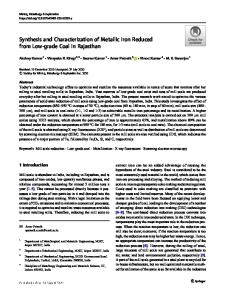Kinetic Study of Iron Dissolution from Low Grade Kaolin Using Oxalic Acid Solutions
- PDF / 485,877 Bytes
- 7 Pages / 612 x 792 pts (letter) Page_size
- 96 Downloads / 329 Views
Kinetic Study of Iron Dissolution from Low Grade Kaolin Using Oxalic Acid Solutions A. Martínez-Luévanos1, L. E. Serrato-Villegas1, M. G. Rodríguez-Delgado1, F. R. CarrilloPedroza2. 1 Facultad de Ciencias Químicas, Universidad Autónoma de Coahuila, Blvd. V. Carranza y González. Lobo s/n, Col. República, C. P. 25280; Saltillo, Coah., México. 2 Facultad de Metalurgia, Universidad Autónoma de Coahuila, 25280 Saltillo, Coah., México. ABSTRACT Kaolin is an important material that is used in industrial applications, including ceramics, paper, paints, fiberglass, inks, pharmaceuticals, and cement. The presence of impurities, particularly iron and titanium bearing materials, imparts color to kaolin. During weathering or hydrothermal alteration, significant levels of iron oxides can be deposited that leave a concentrated kaolinitic clay unusable for industrial application. Therefore, several chemical methods have been applied to kaolin beneficiation in order to reduce these contaminants. Ferric oxide dissolution is of particular interest for producers of industrial minerals such as kaolin. The objective of this work was to examine the kinetics of iron dissolution form low grade kaolin using oxalic acid solutions. The effects of acid concentration and reaction temperature were studied. It was determined that the iron dissolution rate increases with oxalic acid concentration, temperature. Leaching data showed that iron dissolution from low grade kaolin is due to diffusion through the product layer. The activation energy of the process was 46.32 kJ/mol. INTRODUCTION Kaolin is an important material that is used in industrial applications, including ceramics, paper, paints, fiberglass, inks, pharmaceuticals, and cement [1]. The presence of impurities, particularly iron and titanium bearing materials, impart color to kaolin. During weathering or hydrothermal alteration, significant levels of iron oxides can be deposited that leave a concentrated kaolinitic clay unusable for industrial application. Therefore, several chemical methods have been applied to kaolin beneficiation in order to reduce these contaminants [2-5]. The kinetics of dissolution of synthetic iron oxides such as hematite, goethite, and magnetite in oxalate and oxalic acid solutions have been extensively studied by several researchers [6-9]. Furthermore, leaching studies have been performed which have employed various chemicals such as oxalic and other organic acids with high grade kaolin samples in order to study iron dissolution [2-5] in the presence of a fermented medium [10-12] and in solutions containing microbially produced oxalic and hydrochloric acid [13] and carbohydrates [8]. Among the chemicals used, organic acids, oxalic and ascorbic acids are the most common because of their effectiveness as solvent reagents [4, 9]. Considerable attention has been paid to mechanism studies which employ synthetic minerals such as hematite, goethite, and magnetite and ignore the complex interactions that can take place in iron dissolution from industrial minerals such as
Data Loading...











